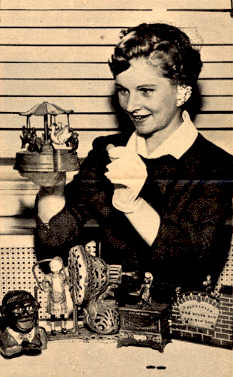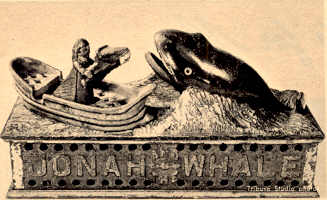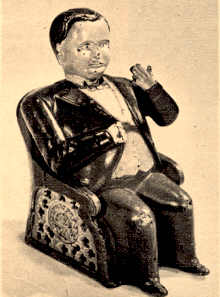| CHICAGO TRIBUNE
MAGAZINE, Pg. 56, December 11, 1955 When Thrift Was Both a Virtue and Fun The Mechanical Penny Banks of the Eighties and Gay Nineties Gave Kids Action as They Saved. Today, the Banks Are Collectors' Items Worth Up to Many Hundreds of Dollars Apiece By Norman A. Hagman BENJAMIN FRANKLIN was of an inventive turn of mind, but it is not recorded that he ever invented any type of machine which would have further popularized his favorite slogan, "A penny saved is a penny earned."
This ancient homily, however, gathered force throughout the intervening years and, by the very late '70s, hundreds of ingenious tinkers, artisans, and inventors had fashioned many penny bank models to capitalize on a nation-wide trend toward thriftiness. Be it ever to their credit — these crafty craftsmen traded on a simple psychological discovery; it was fun to save money if you could have action for your money without spending it.
Young America responded with a notable enthusiasm and, presumably, worked on fond parents, grandparents, aunts, and uncles with a vigor akin to that of today's moppets who have made box top gimmicks a multi-million dollar business. Besides, saving money was a commendable virtue, especially in a day and age when the dollar — unlike today's watered-down version — was worth exactly a hundred cents. Indeed, the dollar, and often a little more, was the going day's wage for the adult male.
Fertile imaginations, coupled with expanding manufacturing facilities, created penny banks in widely diversified shapes, sizes, and ideas. All embodied some type of mechanical action, either by gravity or by the release of a spring operated plunger. At any rate, the penny was deposited or catapulted into a concealed receptacle with a satisfying plunk. The "still " banks — the ones with merely a slot to receive the coin — expired quietly. Parents no long had to prate of the necessity of laying by for a rainy day. The better the penny bank action, the bigger the urge to save.
A
few of these banks were pressed tin, but most were made of the readily
available cast iron. Why wasn't aluminum used? Remember, at this time this
metal was practically nonexistent. It was so scarce that it was used to
cap the Washington monument as evidence of its rarity. |




